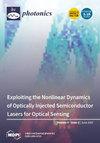Sub-Nanosecond, High Peak Power Yb:YAG/Cr4+:YAG/YVO4 Passively Q-Switched Raman Microchip Laser with the Emission of Multiple Pulses
IF 1.9
4区 物理与天体物理
Q2 OPTICS
引用次数: 0
Abstract
This paper demonstrates the capability of sub-nanosecond, high peak power Yb:YAG/Cr4+:YAG/YVO4 passively Q-switched Raman microchip lasers at 1134 nm operated in multiple pulses mode under quasi-continuous-wave (QCW) pumping. Total pulse energy for the Stokes laser was 1.8 mJ with a 4 mm YVO4 crystal and TOC = 16%. The corresponding pulse repetition rate reached 225 kHz within a single pumping pulse. By employing a compact plane-concave cavity and 5 mm YVO4 crystal, the single pulse energy for the Raman laser was further scaled up to 44 μJ. The corresponding peak power was 95 kW. A highest output pulse repetition rate of 87.8 kHz and shortest pulse duration of 464 ps were found for the Raman laser. The results indicate that the Raman microchip laser configuration under QCW LD pumping is a promising approach for developing high peak power, commercial and portable Raman lasers with a pulse duration of several hundred-picoseconds at a pulse repetition rate of hundred kilohertz.可发射多脉冲的亚纳秒、高峰值功率 Yb:YAG/Cr4+:YAG/YVO4 无源 Q 开关拉曼微芯片激光器
本文展示了亚纳秒、高峰值功率 Yb:YAG/Cr4+:YAG/YVO4 被动 Q 开关拉曼芯片激光器在准连续波 (QCW) 泵浦下以多脉冲模式在 1134 nm 波长工作的能力。斯托克斯激光器的总脉冲能量为 1.8 mJ,晶体为 4 mm YVO4,TOC = 16%。单个泵浦脉冲的相应脉冲重复率达到 225 kHz。通过采用紧凑的平面凹腔和 5 毫米 YVO4 晶体,拉曼激光器的单脉冲能量进一步提高到 44 μJ。相应的峰值功率为 95 kW。拉曼激光器的最高输出脉冲重复率为 87.8 kHz,最短脉冲持续时间为 464 ps。结果表明,在 QCW LD 泵浦下的拉曼微芯片激光器配置是开发峰值功率高、脉冲持续时间长达几百皮秒、脉冲重复频率为几百千赫兹的商用便携式拉曼激光器的可行方法。
本文章由计算机程序翻译,如有差异,请以英文原文为准。
求助全文
约1分钟内获得全文
求助全文
来源期刊

Photonics
Physics and Astronomy-Instrumentation
CiteScore
2.60
自引率
20.80%
发文量
817
审稿时长
8 weeks
期刊介绍:
Photonics (ISSN 2304-6732) aims at a fast turn around time for peer-reviewing manuscripts and producing accepted articles. The online-only and open access nature of the journal will allow for a speedy and wide circulation of your research as well as review articles. We aim at establishing Photonics as a leading venue for publishing high impact fundamental research but also applications of optics and photonics. The journal particularly welcomes both theoretical (simulation) and experimental research. Our aim is to encourage scientists to publish their experimental and theoretical results in as much detail as possible. There is no restriction on the length of the papers. The full experimental details must be provided so that the results can be reproduced. Electronic files and software regarding the full details of the calculation and experimental procedure, if unable to be published in a normal way, can be deposited as supplementary material.
 求助内容:
求助内容: 应助结果提醒方式:
应助结果提醒方式:


